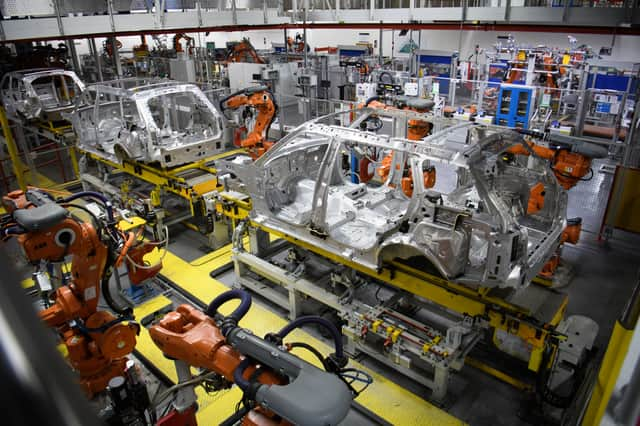Why is there a chip shortage? Global semiconductor supply crisis explained - and impact on car manufacturers
This article contains affiliate links. We may earn a small commission on items purchased through this article, but that does not affect our editorial judgement.


Jaguar Land Rover has said the global semiconductor shortage is partly to blame for a £9 million loss in the last three months of 2021.
The premium British car maker said sales were down 37% compared with the previous year as its factories struggled to secure vital electronic components.
Advertisement
Hide AdAdvertisement
Hide AdJLR’s problem is reflected across the car industry, where chip supply shortages have left manufacturers struggling to meet demand for cars and contributed to a slump in new car sales and rise in used car values.
Some car makers are reporting waiting times of up to a year for certain models. Some, including Toyota and Nissan, have scaled back production and others such as BMW, Ford and Volvo have removed certain features from some cars to enable them to continue production.


The problem, however, runs much deeper than the car industry, affecting everything from mobile phones, games consoles and televisions to medical devices and microwaves.
Why is there a chip shortage?
The Covid pandemic has contributed significantly to the semiconductor supply problems around the world.
Advertisement
Hide AdAdvertisement
Hide AdFactory shutdowns and social distancing measures led to delays in production at already busy factories.
Making matters worse, the pandemic has led to a huge shift towards home working, which has increased demand for technology such as laptops, tablets and webcams, as well as more pressure on internet services and cloud computing facilities. This demand for more high-tech equipment has led to higher demand for the semiconductors which allow it to function.
According to trade body the Semiconductor Industry Association, sales of chips actually fell 12% in 2019 but were already growing (up 6.5%) in 2020 before rocketing by 30% between August 2020 and August 2021.
The value of semiconductors has historically been quite volatile, meaning makers don’t want to over-invest in multi-billion-pound factories for fear demand will disappear and profits could collapse at any moment. That means the industry is now playing catch-up to meet sustained demand for chips in everything from smartphones to cars with advanced driver assistance technology and cloud-connect infotainment systems.
Advertisement
Hide AdAdvertisement
Hide AdThe car industry is among those feeling the shortage most acutely. At the start of the pandemic, manufacturers scaled back their production plans as demand for cars fell away. That, combined with the fact that the automotive sector is a relatively small part of the chip makers’ business, means they are now at the back of the queue when it comes to securing the vital electronic components.
However, the issues run deeper than Covid-related problems and some observers say that the industry was unprepared for such a sharp rise. Former Intel board member Professor David Yoffie, from Harvard Business School, says that the industry hadn’t appreciated how sustained demand would be and was only now responding.
Other more wide-reaching issues have also affected supplies. More than 80% of the world’s semiconductor production is centred in Taiwan and Korea. Taiwan recently experienced its worst drought in 50 years, affecting production, and factory fires in Korea also harmed output. In the US heavy storms in Texas in 2021 forced a major chip producer to shut down factories.
Even the blocking of the Suez Canal for six days by the Ever Given last year had an impact, delaying chip supplies from the Far East to manufacturers in Europe.
Advertisement
Hide AdAdvertisement
Hide AdThe solution to the shortage is to build new factories. However, not only does this take a lot of time but some manufacturers are wary of investing huge amounts in new facilities for fear that demand will drop away. Professor Yoffie told Wired: “If you look at the history of the semiconductor industry, there are surges in profitability and price followed by spectacular down cycles.
“What we just don’t know is whether this ongoing growth in demand will continue.”
When will the shortage end?
JLR’s sales announcement was fairly typical of industry expectations, predicting that the problem will continue throughout this year but gradually improve.
Intel’s Pat Gelsinger has said matters will improve in 2022 but problems will continue into 2023.
Advertisement
Hide AdAdvertisement
Hide AdConsultancy firm Deloitte estimates that around $6 billion will be invested in semiconductor production in 2022, increasing production by 36%. However, it has warned that the problems will continue in early 2023, a view echoed by analysts at JP Morgan.
Sandeep Deshpande, head of European technology research at J.P. Morgan, commented in December 2021: “We believe that semi device companies will get access to more foundry capacity over the next 12 months. However, the shortages faced in autos and industrial end markets will not end fully until new capacity comes on-stream.”
A report by the US Department of Commerce based on responses from 150 chip makers also suggests it will be mid-2022 before the situation improves.
A message from the editor:
Thank you for reading. NationalWorld is a new national news brand, produced by a team of journalists, editors, video producers and designers who live and work across the UK. Find out more about who’s who in the team, and our editorial values. We want to start a community among our readers, so please follow us on Facebook, Twitter and Instagram, and keep the conversation going. You can also sign up to our newsletters and get a curated selection of our best reads to your inbox every day.
Comment Guidelines
National World encourages reader discussion on our stories. User feedback, insights and back-and-forth exchanges add a rich layer of context to reporting. Please review our Community Guidelines before commenting.
